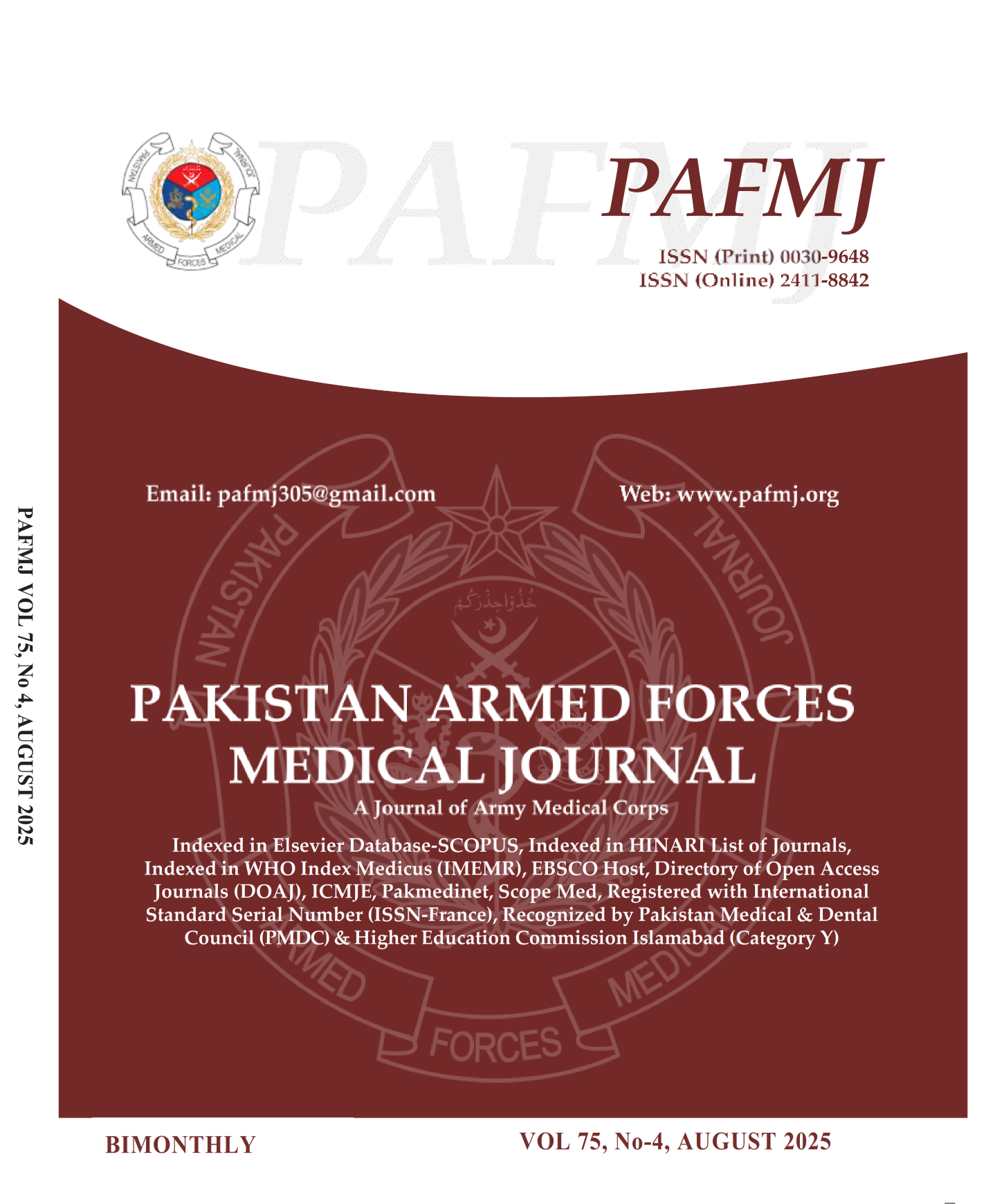Comparison of Treatment Modalities for Management of Pain in Pediatric Gartland Type I Extension Type Supracondylar Humerus Fractures Using Above Elbow Backslab (Splint Immobilization) Versus Collar and Cuff
DOI:
https://doi.org/10.51253/pafmj.v75i4.11351Keywords:
Above elbow backslab, Collar and cuff, Gartland Type I, Pain, Supracondylar fracture.Abstract
Objective: To compare the effectiveness of the above elbow backslab versus collar and cuff sling to treat Gartland Type I supracondylar fracture in terms of better pain control.
Study Design: Quasi experimental study.
Place and Duration of Study: Department of Orthopedic Surgery, Federal Government Polyclinic Hospital, Islamabad, Pakistan, from Jan 2020 to Jan 2021.
Methodology: The study enrolled a total of 60 pediatric patients who suffered from extension type Gartland Type I supracondylar fracture, with 30 patients allocated to one of two groups. In Group A, the fracture was managed by using above elbow backslab and in Group B, the collar and cuff sling was utilized. Post-treatment pain evaluation at the fracture site was done using the Visual Analogue Scale (VAS).
Results: The mean age of the patients was 7.35±1.94 years, comprising of 37(61.7%) males and 23(38.3%) females. Significant pain (VAS ≥4) was present in 4(13.3%) patients from Group A and 15(50%) patients from Group B, which was noted to be statistically significant (p-value=0.02).
Conclusion: Management of Supracondylar fracture Gartland Type I with above elbow backslab was associated with less incidence and decreased severity of pain as compared to management by collar and cuff.
Downloads
References
1. Shah M, Agashe MV. Supracondylar humerus fractures: Classification-based treatment algorithms. Indian J Orthop 2020; 55(1): 68–80.
https://doi.org/10.1007/s43465-020-00285-2
2. Shenoy PM, Islam A, Puri R. Current management of pediatric supracondylar fractures of the humerus. Cureus 2020; 12(5): e8137.
3. Siddiqui AA, Kumar J, Adeel M, Yaqoob U, Rajput MI. Prevalence of vitamin D deficiency in children presenting with supracondylar fractures of humerus. Int J Clin Pract 2021; 75(5): e14056. https://doi.org/10.1111/ijcp.14056
4. LiBrizzi CL, Klyce W, Ibaseta A, Shannon C, Lee RJ. Sex-based differences in pediatric supracondylar humerus fractures. Medicine 2020; 99(20): e20267.
https://doi.org/10.1097/MD.0000000000020267
5. Smuin D, Hatch M, Winthrop Z, Gidvani S, Hennrikus W. The reduction maneuver for pediatric extension type-III supracondylar humerus fractures. Cureus 2020; 12(7): e9213. https://doi.org/10.7759/cureus.9213
6. Duffy S, Flannery O, Gelfer Y, Monsell F. Overview of the contemporary management of supracondylar humeral fractures in children. Eur J Orthop Surg Traumatol 2021; 31(5): 871–881. https://doi.org/10.1007/s00590-021-02932-2
7. Delniotis I, Dionellis P, Gekas CC, et al. Flexion-type supracondylar humeral fracture with ulnar nerve injury in children: Two case reports and review of the literature. Am J Case Rep 2020; 21: e921293.
https://doi.org/10.12659/AJCR.921293
8. Mallo G, Stanat SJ, Gaffney J. Use of the Gartland classification system for treatment of pediatric supracondylar humerus fractures. Orthopedics 2010; 33(1): 19.
https://doi.org/10.3928/01477447-20091124-08
9. Teo TL, Schaeffer EK, Habib E, et al. Is the modified Gartland classification system important in deciding the need for operative management of supracondylar humerus fractures? J Child Orthop 2020; 14(6): 502–507.
https://doi.org/10.1302/1863-2548.14.200093
10. Coupal S, Lukas K, Plint A. Management of Gartland type I supracondylar fractures: A systematic review. Front Pediatr. 2022; 10: 863985. https://doi.org/10.3389/fped.2022.863985
11. Ballal MS, Garg NK, Bass A, Bruce CE. Comparison between collar and cuffs and above-elbow back slabs in the initial treatment of Gartland type I supracondylar humerus fractures. J Pediatr Orthop B 2008; 17(2): 57–60.
https://doi.org/10.1097/BPB.0b013e3282f3d162
12. Giannoudis VP, Rodham P, Giannoudis PV, Kanakaris NK. Severely injured patients: Modern management strategies. EFORT Open Rev 2023; 8(5): 382–396.
https://doi.org/10.1530/EOR-23-0053
13. Goudman L, Pilitsis JG, Billet B. The level of agreement between the numerical rating scale and visual analogue scale for assessing pain intensity in adults with chronic pain. Anaesthesia 2024; 79(2): 128–138.
https://doi.org/10.1111/anae.16151
14. Micheloni GM, Novi M, Leigheb M, Giorgini A, Porcellini G, Tarallo L, et al. Supracondylar fractures in children: Management and treatment. Acta Biomed 2021; 92(Suppl 3): e2021015.
15. Canales-Zamora OA, Mora-Ríos FG, Mejía-Rohenes LC, Anaya-Morales A, González-Gijón OR, López-Hernández JR et al. Complicaciones de fracturas supracondíleas humerales en niños [Complications of supracondylar humeral fractures in children]. Acta Ortop Mex 2020; 34(2): 91–95.
16. Tomaszewski R, Wozowicz A, Wysocka-Wojakiewicz P. Analysis of early neurovascular complications of pediatric supracondylar humerus fractures: A long-term observation. Biomed Res Int 2017; 2017: 2803790.
https://doi.org/10.1155/2017/2803790
17. Wilkins KE. Changing patterns in the management of fractures in children. Clin Orthop Relat Res. 1991; (264): 136–155.
18. Leitch KK, Kay RM, Femino JD, Tolo VT, Storer SK, Skaggs DL et al. Treatment of multidirectionally unstable supracondylar humeral fractures in children. A modified Gartland type-IV fracture. J Bone Joint Surg Am 2006; 88(5): 980–985.
https://doi.org/10.2106/JBJS.D.02956
19. Oakley E, Barnett P, Babl FE. Backslab versus non-backslab for immobilization of undisplaced supracondylar fractures: A randomized trial. Pediatr Emerg Care. 2009; 25(7): 452–456.
https://doi.org/10.1097/PEC.0b013e3181ab7898
20. Dunlop L. Supracondylar fractures. Don't Forget the Bubbles. 2019.
Downloads
Published
Issue
Section
License
Copyright (c) 2025 Yasir Umer, Syed Junaid Ismail, Amir Nisar, Waleed Umer, Nadia Junaid

This work is licensed under a Creative Commons Attribution-NonCommercial 4.0 International License.















